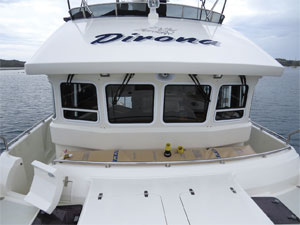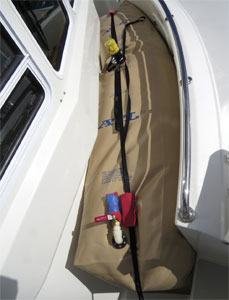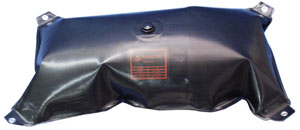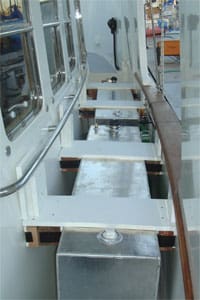Heading out to sea for an extended-range passage requires careful planning. With so many modern advances, it is possible for just about anyone with the desire to take off beyond the horizon to venture to the far corners with relative ease if suitably prepared. And one way to prepare for long-range trips is to add extra fuel capacity via fuel bladders.
The development of continuous-duty diesel engines coupled with high reduction gear transmissions and large-diameter propellers makes it possible for a full-displacement powerboat as small as 40 feet long to achieve nonstop distances in the 3,000-mile range that can be strung together to complete a circumnavigation. I was fortunate to participate in one of the most famous recreational trawler marketing feats ever attempted by crewing on a leg of the Nordhavn 40 Around the World trip — proving that PAE’s smallest stock production trawler could circle the globe as designed with no additional fuel carried, setting a world record for the smallest production powerboat to circumnavigate.
Cruising sailboats typically rely on the wind to sail long stretches, but also are usually set up with a small diesel engine to power through the hard-to-predict soft areas of little to no wind. It is common to see long-distance sailboats set out to sea with several jerry jugs filled with diesel lashed to their decks to help make landfall. Taking on additional fuel to supplement the standard diesel fuel capacity is prudent to minimize the possibility of running out before arrival.
There are a handful of trawler brands that have successfully completed long-range ocean passages. An ocean-crossing powerboat, in addition to having enough room for essential provisions like food and water, must also have the navigation equipment to stay on course and — most importantly — it needs to have the range to travel at slow speeds 24/7 for up to two weeks or more to safely arrive at the intended destination.
Most long-range cruising trawlers have substantial standard fuel tank capacity and they are designed from the start to carry enough fuel to supply the ship for an ocean-crossing distance of nominally 3,000-plus miles. The goal is to plan the trip so that you arrive safely with roughly 10 percent of your fuel in reserve; this safety margin of remaining fuel is an essential strategy to complete the trip.
 |
|
James and Jennifer Hamilton on the Nordhavn 52 Dirona used a 360-gallon ATL bladder designed to fit into their Portuguese bridge. |
|
James R. Hamilton |
Knowledge of fuel burn rate
Knowing your fuel burn at various rpm will enable you to calculate the proper underway speed. Before any long passage is contemplated, you must have an accurate understanding of fuel burn/rpm/speed in fully loaded condition. Keep in mind that you need to know the numbers on your generator(s) too if you need to fire one up to make water or run air conditioning.
It is also essential to know exactly how much fuel your tanks truly can contain, and you need a plan to be able to take advantage of every last drop, so make sure these considerations are part of your trip planning. It’s pretty obvious when you do the math, but you need to get to the halfway point of your trip with more than half of the fuel required to finish the journey.
The modern trawler can be outfitted with a watermaker to restore freshwater reserves and alternators and/or generators for battery charging, but you can’t produce fuel so you have to be efficient in managing your diesel consumption. Tortoise speeds are necessary; many passages begin with a fully laden trawler taking off at very slow speeds — 5 knots is not uncommon — and as time and distance are achieved the boat sheds the weight of fuel. As long as you know your burn rate you can determine when to pick up speed, all the while understanding that you need to arrive at your destination with fuel to spare.
Taking a clue from sailors, many long-range powerboats have elected to supplement the standard fuel storage capacity by adding fuel bladders, barrels and/or tanks. This has three major advantages: 1) extended range to travel farther, 2) the choice of a slightly faster cruising speed, and 3) added peace of mind that should you need to adjust your destination or have a miscalculation in your consumption you have a little more room for error.
The downside is the additional weight aboard and determining the optimum way to safely secure and easily access your supplemental container(s) to transfer fuel into your standard tanks. Additional fuel capacity is becoming more common — even on trawler brands that tout long-range performance — simply because it is available at a reasonable cost and provides an easy solution to a commodity that can’t be self-sufficiently generated.
Discussion with long-range voyagers
To gather insights into their decisions to add extra fuel for long ocean passages, I have discussed the addition of extra fuel with several cruising clients of mine: Larry Straight on the Nordhavn 46 Arcadia I; Don and Paulie Grover aboard the Nordhavn 46 Stormhaven; Adam and Eve Block from the Nordhavn 47 Eden; James and Jennifer Hamilton on the Nordhavn 52 Dirona; and Ned Lambton along with Captain Oleg Korbyn from the Nordhavn 62 Lone Wolf. Interestingly, each of these crews added fuel for Pacific crossings and each boat was designed without the necessity to require additional fuel; however, they all felt much safer doing so and employed similar strategies to reach their desired port of call. Power cruisers using different makes of boats do operate with similar philosophies and strategies.
Fuel is heavy (diesel weighs 7.5 pounds/3.4 kilograms per gallon) so the placement of additional tanks and their effect on boat trim is another critical factor to evaluate. Equally important is a means of securing the tanks and having a plumbing arrangement to divert the extra fuel from on deck to your ship’s built-in tanks. Here are some examples of different solutions to this intriguing proposition:
The Grovers on the 46 Stormhaven used 60-gallon plastic barrels and secured them in their Portuguese bridge just forward of the pilothouse, rigging them with hoses and valves and cam locks. Wichard folding pad eyes and stainless bales welded on chain plates allowed Don to lash the barrels in place. On the 46, the port forward tank is higher than the other three fuel tanks and the deck fill is more protected than the other fill locations, so this was designated to be the primary refill location. Don was careful while transferring to not let any salt water get into his tanks. Don would use 50 gallons out of his port forward tank and then refill from a barrel using a small pump. They carried three barrels in their Portuguese bridge, yielding an additional 180 gallons of fuel that, at 5 knots, gave them additional range of a couple hundred miles. On their passage to the Marquesas they arrived with 500 gallons to spare, so it wasn’t necessary in hindsight but gave them comfort to know they had some extra legs.
Larry Straight on Arcadia I did not want to use bladders because the only place he could secure them was in his aft deck cockpit, which would have prevented him from accessing his steering gear in the lazarette. He viewed the starboard-side deck walkway as a secure walled-in location and bought two 90-gallon aluminum tanks (intended for installation across the front of a pickup truck bed) and then, using HPDE lumber, built a tight-fitting frame for the tanks that required minimal drilling (see photo). His strategy was to run down his fuel supply from his forward starboard tank first, which helped balance his trim and created space to fill from his side deck tanks. The aluminum tanks had hoses and valves installed and, when the sea conditions were calm, Larry could siphon some fuel to fill up his onboard tanks. The tanks were equipped with a drain valve on the bottom and, using gravity, Larry would feed fuel into his standard diesel tank deck fittings.
Adam and Eve on the 47 Eden and the Hamiltons on the 52 Dirona purchased fuel bladders from Aero Tec Laboratories (ATL) to add reserve diesel fuel tankage.
 |
|
The Hamiltons' ATL bladder in their Portuguese bridge. |
|
James R. Hamilton |
Adam told me they first tried securing a Petroflex 100-gallon bladder on the foredeck but got concerned with the tie-downs when the bladder tended to shift a bit in a rolling sea. They later changed locations to the cockpit and added a second 150-gallon FueLocker.
On their 2,600-mile trip from Los Cabos, Mexico, to the Marquesas, they wanted some range insurance. Once they settled on the mounting locations, the task of filling the bladders was made easier by raising the top fill spout as high as possible by hoisting it from the overhead deck (imagine trying to fill a bladder without a lifting support — the fill location would want to collapse into the center and the diesel would want to gush out and spill all over). The hardest part was finding a solution of cross-strapping with 2-inch webbing and ratchets to create a downward force that would pin down the bladders and could be cinched as they were dispensed. The additional 250 gallons of fuel added 1,750 pounds of weight that was fine being distributed along the aft deck. Gravity draining was far too slow so they installed a 110V 1-inch pump plumbed to the barbed discharge on the bladder and put the cut hose end down into the standard diesel fuel fill deck plates with towels wrapped around to cover the gaps and prevent salt water from getting into the tanks. Their system allowed them to pump 6 gallons of fuel per minute, a chore they did when they had smooth seas. The ability to run 0.3 to 0.5 knots faster than they would have without bladders shortened the length of the trip and provided extended range if they had to change course to a different port of call.
James and Jennifer on Dirona used similar sized bladders to Eden’s in the cockpit, but also added a custom 360-gallon bladder designed to fit snugly into their Portuguese bridge. Dirona has ocean-crossing range with her standard 1,750-gallon onboard tankage, but with the bladders full they can carry 2,710 gallons, which means 3,500-nm range is much easier to achieve.
James and Jennifer recently traveled 3,023 nm from Dampier, Australia, to Rodrigues, Mauritius, at 6.6 knots with plenty of fuel in reserve on arrival. Long passages can expose a crew to the risk of bad weather that may force changes in course and speed. Having more fuel gives the Hamiltons more flexibility in their travels. Dirona improved on the system used on Eden by installing a cam-lock system and vapor return that matched the delivery pump speed to make filling and dispensing relatively easy. To drain a bladder, the cam-lock covers are removed and a fuel hose snaps in place. Then, a valve is opened (from inside the boat) and the fuel transfer pump routes the diesel to the receiving onboard tank. The idea of building a custom bladder makes a lot of sense for a boat expecting to make multiple long-distance passages because you can specify attachment points as well as the fill and supply connections to maximize utility.
 |
|
A Nauta fuel bladder from Imtra with corner grommets. Additional rope or strapping is often needed to ensure the bladder stays put during rough weather. |
|
Courtesy Imtra |
The 62 Lone Wolf also used a bladder system. Captain Oleg Korbyn did some research online and then purchased the Nauta 300-gallon nitrile bladder from IMTRA and lashed it to the port side of the foredeck using the built-in bladder attachment points. The calculated weight of the fuel bladder (285 gallons) was approximately 2,200 pounds and was positioned where a similar weight tender had been installed so the trim effect was unnoticeable. They used the supplied tie-downs and straps with buckles and lashed to existing deck hardware. A filler was fashioned using a valve and connector to fill the mid tank when it was depleted. The real benefit was knowing that they had an extra 50 hours of running time on their transit from Puerto Vallarta to Nuku Hiva and could be more relaxed about maintaining cruising speed in unfavorable conditions as well as running the generator and appliances. When they arrived, they rolled up the tank and reclaimed the deck space.
Timing of fuel transfer important
Each of the crews was unanimous in suggesting that the timing of fuel transfer at sea is important. Ideally this is done in smooth seas to minimize the chance of leaks and to prevent seawater from getting into your onboard tank fills.
There are many passagemakers who have completed impressive trips without adding additional fuel, but the advantages of a well thought-out, properly placed and relatively easy refill system makes setting out to sea with a far away piece of land as your destination much less stressful and easier to accomplish.
A special thanks to the crews of the Nordhavns mentioned in this article for their insights. No doubt there are other cruisers who have come up with equally creative solutions to extend range — if you have come up with a unique option on your boat, I’d be very interested to hear from you and look at your photos.
Jeff Merrill, CPYB, is the president of Jeff Merrill Yacht Sales, Inc.- www.JMYS.com. Merrill is active in the cruising community as a public speaker and writer and enjoys spending time at sea with clients. Jeff is a regular contributor to the Power Voyaging column and is constantly looking for new ideas to improve and simplify the trawler lifestyle. If you have a suggestion or want to get in touch e-mail Merrill at: trawlerspecialist@gmail.com.

